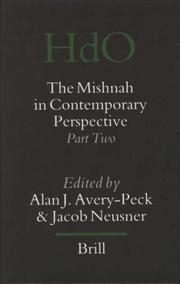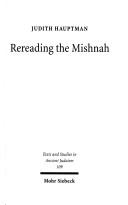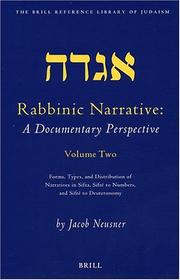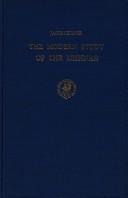| Listing 1 - 10 of 29 | << page >> |
Sort by
|
Book
ISBN: 1783746823 1783746815 1783746807 9791036566899 Year: 2020 Publisher: Cambridge, England : Open Book Publishers,
Abstract | Keywords | Export | Availability | Bookmark
 Loading...
Loading...Choose an application
- Reference Manager
- EndNote
- RefWorks (Direct export to RefWorks)
This volume presents a collection of articles centring on the language of the Mishnah and the Talmud - the most important Jewish texts (after the Bible), which were compiled in Palestine and Babylonia in the latter centuries of Late Antiquity. Despite the fact that Rabbinic Hebrew has been the subject of growing academic interest across the past century, very little scholarship has been written on it in English. Studies in Rabbinic Hebrew addresses this lacuna, with eight lucid but technically rigorous articles written in English by a range of experienced scholars, focusing on various aspects of Rabbinic Hebrew: its phonology, morphology, syntax, pragmatics and lexicon. This volume is essential reading for students and scholars of Rabbinic studies alike, and appears in a new series, Cambridge Semitic Languages and Cultures, in collaboration with the Faculty of Asian and Middle Eastern Studies at the University of Cambridge. As with all Open Book publications, this entire book is available to read for free on the publisher’s website. Printed and digital editions, together with supplementary digital material, can also be found here: www.openbookpublishers.com
Mishnah. --- Mishna --- Mishnayot --- Mischnajot --- Mischna --- Mishne --- Michnah --- Mišnâh --- Mišna --- Mishnayoth --- Mishno --- Shishah sidre Mishnah --- משנה --- ששה סדרי משנה --- משניות

ISBN: 9004152202 9004125159 9789004152205 9786611399689 128139968X 9047410068 9004294228 9789004125155 9789004294226 9789047410065 Year: 2006 Volume: 65, 87 Publisher: Leiden Boston Brill
Abstract | Keywords | Export | Availability | Bookmark
 Loading...
Loading...Choose an application
- Reference Manager
- EndNote
- RefWorks (Direct export to RefWorks)
This second volume of a two-part project on the Mishnah displays a broad selection of approaches to the study of the Mishnah in the contemporary academy. The work derives from Israel, North America, and Europe and shows the intellectual vitality of scholarship in all three centers of learning. What these articles show in diverse ways is that the Mishnah forms a critical focus of the study of Judaism. The authors of these studies represent the best of contemporary scholarship on the Mishnah. Because of the many viewpoints included here, this is the most representative selection of contemporary Mishnah-study available in any collection in a Western language.
Mishnah --- 296*21 --- Misjna --- 296*21 Misjna --- Criticism, interpretation, etc --- History --- Criticism, interpretation, etc. --- History. --- Mishna --- Mishnayot --- Mischnajot --- Mischna --- Mishne --- Michnah --- Mišnâh --- Mišna --- Mishnayoth --- Mishno --- Shishah sidre Mishnah --- משנה --- ששה סדרי משנה --- משניות

ISBN: 3161487133 9783161487132 Year: 2005 Publisher: Tübingen Mohr Siebeck
Abstract | Keywords | Export | Availability | Bookmark
 Loading...
Loading...Choose an application
- Reference Manager
- EndNote
- RefWorks (Direct export to RefWorks)
Interpretation. --- Misjna. --- Tosefta. --- Mishnah --- Mishnah. --- Tosefta --- Criticism, interpretation, etc. --- 296*21 --- 296*21 Misjna --- Misjna --- Tosephta --- Thoseftha --- Mishna --- Mishnayot --- Mischnajot --- Mischna --- Mishne --- Michnah --- Mišnâh --- Mišna --- Mishnayoth --- Mishno --- Shishah sidre Mishnah --- משנה --- ששה סדרי משנה --- משניות

ISBN: 1280467487 9786610467488 1423711947 9047402235 9781423711940 9789047402237 9789004130340 9004130349 Year: 2003 Publisher: Leiden Brill
Abstract | Keywords | Export | Availability | Bookmark
 Loading...
Loading...Choose an application
- Reference Manager
- EndNote
- RefWorks (Direct export to RefWorks)
Each Rabbinic document, from the Mishnah through the Bavli, defines itself by a unique combination of indicative traits of rhetoric, topic, and particular logic that governs its coherent discourse. But narratives in the same canonical compilations do not conform to the documentary indicators that govern in these compilations, respectively. They form an anomaly for the documentary reading of the Rabbinic canon of the formative age. To remove that anomaly, this project classifies the types and forms of narratives and shows that particular documents exhibit distinctive preferences among those types. This detailed, systematic classification of Rabbinic narrative supplies these facts concerning the classification of narratives and their regularities: [1] what are the types and forms of narrative in a given document? [2] how are these distinctive types and forms of narrative distributed across the canonical documents of the formative age, the first six centuries C.E.? The answers for the documentary preferences are in Volumes One through Three, for the Mishnah-Tosefta, the Tannaite Midrash-compilations, and Rabbah-Midrash-compilations, respectively. Volume Four then sets forth the documentary history of each of the types of Rabbinic narrative, including the authentic narrative, the ma'aseh and the mashal. How the traits of the several types of narratives shift as the respective types move from document to document is spelled out in complete detail. This project opens an entirely new road toward the documentary analysis of Rabbinic narrative. It fills out an important chapter in the documentary hypothesis of the Rabbinic canon in the formative age.
Midrash --- Narration in rabbinical literature. --- Parables in rabbinical literature. --- Rabbinical literature --- History and criticism. --- Mishnah --- Mishna --- Mishnayot --- Mischnajot --- Mischna --- Mishne --- Michnah --- Mišnâh --- Mišna --- Mishnayoth --- Mishno --- Criticism, Narrative. --- Shishah sidre Mishnah --- משנה --- ששה סדרי משנה --- משניות
Book
ISBN: 1555407137 Year: 1992 Volume: vol 47 Publisher: Atlanta Scholars Press
Abstract | Keywords | Export | Availability | Bookmark
 Loading...
Loading...Choose an application
- Reference Manager
- EndNote
- RefWorks (Direct export to RefWorks)
296*212 --- Rabbinical literature --- -Hebrew literature --- Jewish literature --- Tosefta --- History and criticism --- -Tosefta --- 296*212 Tosefta --- -296*212 Tosefta --- Mishnah --- Tosephta --- Thoseftha --- Mishna --- Mishnayot --- Mischnajot --- Mischna --- Mishne --- Michnah --- Mišnâh --- Mišna --- Mishnayoth --- Mishno --- Criticism, interpretation, etc. --- Comparative studies. --- Criticism, Redaction. --- Introductions. --- Comparative studies --- Criticism [Redaction ] --- Introductions --- Shishah sidre Mishnah --- משנה --- ששה סדרי משנה --- משניות
Book
ISBN: 1555408729 Year: 1993 Volume: 83 Publisher: Atlanta Scholars Press
Abstract | Keywords | Export | Availability | Bookmark
 Loading...
Loading...Choose an application
- Reference Manager
- EndNote
- RefWorks (Direct export to RefWorks)
296 <08> --- Judaism --- -Jews --- Religions --- Semites --- Jews --- Judaïsme. Jodendom--Verzamelwerken. Reeksen --- History --- -Religion --- Religion --- Sanders, E. P. --- Sanders, Ed, --- -Judaïsme. Jodendom--Verzamelwerken. Reeksen --- -Sanders, E. P. --- Mishnah --- Mishna --- Mishnayot --- Mischnajot --- Mischna --- Mishne --- Michnah --- Mišnâh --- Mišna --- Mishnayoth --- Mishno --- Criticism, interpretation, etc. --- Criticism, interpretation, etc --- Talmudic period, 10-425 --- Shishah sidre Mishnah --- משנה --- ששה סדרי משנה --- משניות

ISBN: 9004036695 9789004036697 9789004509009 Year: 1973 Volume: v. 23 Publisher: Leiden: Brill,
Abstract | Keywords | Export | Availability | Bookmark
 Loading...
Loading...Choose an application
- Reference Manager
- EndNote
- RefWorks (Direct export to RefWorks)
Jewish learning and scholarship --- Juifs --- Savoir et érudition --- Mishnah --- Criticism, interpretation, etc. --- History --- Criticism, interpretation, etc --- 296*21 --- Misjna --- Jewish learning and scholarship. --- History. --- 296*21 Misjna --- Savoir et érudition --- Jews --- Learning and scholarship --- Intellectual life --- Mishna --- Mishnayot --- Mischnajot --- Mischna --- Mishne --- Michnah --- Mišnâh --- Mišna --- Mishnayoth --- Mishno --- Shishah sidre Mishnah --- משנה --- ששה סדרי משנה --- משניות --- Historical criticism
Book
ISBN: 1555403239 9781555403232 Year: 1989 Volume: 168 Publisher: Atlanta Scholars Press
Abstract | Keywords | Export | Availability | Bookmark
 Loading...
Loading...Choose an application
- Reference Manager
- EndNote
- RefWorks (Direct export to RefWorks)
296 --- Judaism --- -Jews --- Religions --- Semites --- Jews --- Judaïsme. Jodendom --- History --- -Historiography --- Religion --- -Judaïsme. Jodendom --- History&delete& --- Historiography --- Mishnah --- Mishna --- Mishnayot --- Mischnajot --- Mischna --- Mishne --- Michnah --- Mišnâh --- Mišna --- Mishnayoth --- Mishno --- Criticism, interpretation, etc. --- Shishah sidre Mishnah --- משנה --- ששה סדרי משנה --- משניות
Book
ISBN: 9789004347014 9004347011 9789004347021 900434702X Year: 2017 Volume: 55 Publisher: Leiden Brill
Abstract | Keywords | Export | Availability | Bookmark
 Loading...
Loading...Choose an application
- Reference Manager
- EndNote
- RefWorks (Direct export to RefWorks)
In For Out of Babylonia Shall Come Torah and the Word of the Lord from Nehar Peqod , Barak S. Cohen reevaluates the evidence in Tannaitic and Amoraic literature of an independent “Babylonian Mishnah” which originated in the proto-talmudic period. The book focuses on an analysis of the most notable halakhic corpora that have been identified by scholars as originating in the Tannaitic period or at the outset of the amoraic. If indeed such an early corpus did exist, what are its characteristics and what, if any, connection does it have with the parallel Palestinian collections? Was this Babylonian Mishnah created in order to harmonize the Palestinian Mishnah with a corpus of rabbinic teachings already existent in Babylonia? Was this corpus one of the main contributors to the forced interpretations and resolutions found so frequently in the Bavli?
296*2 --- 296*2 Misjna. Talmud. Halachische codices . Responsen --- Misjna. Talmud. Halachische codices . Responsen --- Rabbinical literature --- Tannaim. --- Amorites. --- Judaism --- Rabbinical literature. --- Tanaim --- Tanaites --- Midrash --- Rabbis --- Amoraim --- Hebrew literature --- Jewish literature --- History and criticism. --- History --- Talmudic period. --- Talmudic period --- Mishnah --- Mishnah. --- Mishna --- Mishnayot --- Mischnajot --- Mischna --- Mishne --- Michnah --- Mišnâh --- Mišna --- Mishnayoth --- Mishno --- History. --- 10-425
Book
ISBN: 9786610760213 1280760214 0198021909 0195359860 9780198021902 0197738540 Year: 1988 Publisher: New York Oxford University Press
Abstract | Keywords | Export | Availability | Bookmark
 Loading...
Loading...Choose an application
- Reference Manager
- EndNote
- RefWorks (Direct export to RefWorks)
Judith Wegner scrutinizes the Mishnah, the book of legal rules produced by Jewish sages in second-century Palestine, and determines its effect upon the image and status of women in the Jewish orthodox tradition.
Mishnah -- Criticism, interpretation, etc. --- Mishnah. --- Women in rabbinical literature. --- Women in rabbinical literature --- Judaism --- Religion --- Philosophy & Religion --- Women in the Talmud --- Rabbinical literature --- Mishnah --- Criticism, interpretation, etc. --- Mishna --- Mishnayot --- Mischnajot --- Mischna --- Mishne --- Michnah --- Mišnâh --- Mišna --- Mishnayoth --- Mishno --- Shishah sidre Mishnah --- משנה --- ששה סדרי משנה --- משניות
| Listing 1 - 10 of 29 | << page >> |
Sort by
|

 Search
Search Feedback
Feedback About UniCat
About UniCat  Help
Help News
News